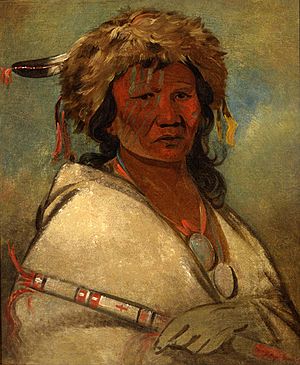Maungwudaus facts for kids


George Henry (1811–1888), also known as Maungwudaus, was an important Ojibwe leader. He was a talented performer and helped people understand each other as an interpreter. He also worked with missions and later became a healer using plants. He could translate the Ojibwe language into English. Towards the end of his life, he was known for his knowledge of herbs.
Contents
Early Life and Education
Maungwudaus was born in 1811. His birthplace was near Forty Mile Creek in Ontario, Canada. His father was Chief Mesquacosy, who fought in the War of 1812. His mother, Tuhbenahneequay (also known as Sarah Henry), was Chief Wahbanosay's daughter. His half-brother was the missionary Peter Jones.
Maungwudaus grew up in the area of the Mississaugas of the Credit First Nation. As a child, he learned a lot about plants and their healing powers. He was raised to respect the Great Spirit and to offer animal sacrifices.
Around 1824, Maungwudaus became a Methodist. He was taught by ministers and went to a mission school near the Credit River. Learning English at this school opened up many new chances for him. He was such a good student that the John Street Methodist Church in New York City paid for his schooling. This was from 1830 to 1831. In May 1831, his wife, Hannah, had their second son, Abraham. The church gave him more money for his studies in 1832. He later taught Sunday school. After a missionary trip with his family in 1832, they moved to Muncey. This town is southwest of London, Ontario.
Career and Cultural Journey
Maungwudaus worked at several missions. He was also a teacher in Muncey during the winter of 1835. He taught in Sarnia, Ontario, as well. In 1837, he was chosen as the third chief of the Credit River Band. He moved to Walpole Island in the 1830s and became a preacher.
In 1840, Maungwudaus worked as a government interpreter at the Saint Clair Mission. He helped James Evans translate Methodist hymns into Ojibwe. A Methodist church committee even suggested he become an assistant missionary. However, around this time, he started to move away from the Canadian Methodist Conference. This was partly due to his half-brother Peter Jones's reaction to his hymn translations.
Despite this, Maungwudaus remained a government interpreter. He continued his role as a Methodist interpreter and translator, though he wasn't as excited about it. In the late 1830s, he decided to use his Ojibwe name, Maungwudaus. He also began to focus more on Ojibwe culture rather than his previous religion. Later, he preferred the Church of England. In July 1844, he briefly worked as an interpreter on Walpole Island.
Traveling Dance Troupe
In the summer of 1844, Maungwudaus put together a dance troupe. It included his family and some non-Christian Ojibwe people from Walpole Island. They planned a tour across England. After deciding to use his Ojibwe name, Maungwudaus, his troupe met many famous people. He also joined the Roman Catholic Church.
From 1845 to 1848, his troupe traveled all over Europe. They performed dances and put on exhibitions. Later, they traveled throughout Canada and the United States. Sadly, during their time in the United States, his wife Hannah and three of their children passed away from smallpox. In the spring of 1851, Maungwudaus left the Roman Catholic Church. His dance troupe kept traveling. In 1852, he married Taundoqua, whom he had met in Michigan in 1851. In 1854, he moved to the Grand River Reserve. There, he wrote a pamphlet about his experiences in Europe.
Later Life and Lasting Impact
In the late 1850s, Maungwudaus decided to become a herbalist. He called himself Dr. Maungwudaus. He knew how to use herbs to cure common sicknesses. His home was filled with herbs hanging from the ceiling, giving off a strong smell. By the mid-1860s, Maungwudaus received many positive reviews from his clients.
The last known newspaper mention of Maungwudaus was in 1877. He was building a canoe for a boat race in Carthage, New York. After that race, there are no more records of him. It is believed he passed away in 1888.
His Legacy in Art
Maungwudaus left a lasting impact through art. In 2002, a painting of him by Paul Kane from 1851 sold for $2.2 million in Calgary. This made it the "second-most valuable artwork" in Canada at the time. Other famous artists also painted portraits of Maungwudaus. These include George Catlin and Théodore Gudin.
Images for kids
-
"Great Hero, a chief" by George Catlin, 1845, Smithsonian American Art Museum
-
Portrait of Maungwudaus by Paul Kane, 1851, Tacoma Art Museum





